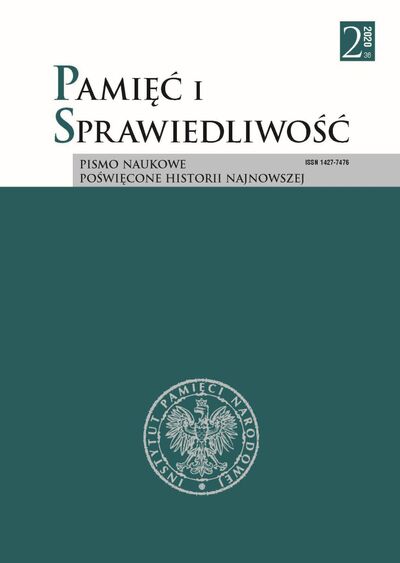Organisation and activities of the Yugoslav communist propaganda in 1945–1950
Pamięć i Sprawiedliwość, Bd. 36 Nr. 2 (2020), pages: 104-117
Publication date: 2020-12-31
 https://doi.org/10.48261/PIS203607
https://doi.org/10.48261/PIS203607
Abstract
The article deals with the organisation and activities of the propaganda apparatus of the Communist Party of Yugoslavia, the so-called Agitprop, in the first five years after World War II. The Agitprop apparatus was a very important part of the Communist Party’s structure, and it had crucial tasks in strengthening its power. Through different forms of activities, Agitprop created a desirable public image of the Communist Party and its policy and ideology. Agitprop worked in everyday ordinary situations in factories, schools, institutions, state bodies, party meetings and special subordinated organisations, syndicates, youth organisations, women’s organisations, etc. Besides this, special mass gatherings, meetings, celebrations, parades were organised at various occasions. Great significance was attached to propaganda’s influence in educational system and culture. The main form of Communist propaganda influence was the press that was completely under the control of the Agitprop. The contents of propaganda in the observed period changed in accordance with the internal and international political situation and the main political goals and needs of Communist Party of Yugoslavia. The article is based on archival sources, published documents, press articles and relevant literature.
Literaturhinweise
Arhiv Jugoslavije (Archives of Yugoslavia)
Arhiv Srbije (Archives of Serbia)
Bilandžić D., Hrvatska moderna povijest (Zagreb: Golden marketing, 1999).
Bondžić D., Bondžić M., “Prvomajske proslave u Beogradu 1945–1950”, Godišnjak grada Beograda 54 (2007).
Bondžić D., “The Communist Party and Celebrations of the Victory Day (9 May) in Yugoslavia 1945–1955”, Pamięć i Sprawiedliwość 2019, vol. 1, no. 33.
Cvetković S., “Represija komunističkog režima u Srbiji i Jugoslaviji 1944–1953. Sa osvrtom na iskustvo Istočne Evrope i Poljske” [in:] Polska i Jugoslavia w stosunkach międzynarodowych po II wojnie światowej. Relacje wielostronne i wielopoziomowe, ed. M. Pavlović, A. Zaćminski (Bydgoszcz: Uniwersytet Kazimierza Wielkiego, 2014).
Dimić L., Agitprop kultura 1945–1952. Agitpropovska faza kulturne politike u Srbiji 1945–1952 (Beograd: Rad, 1988).
Dimić L., “Ideology and Culture in Yugoslavia (1945–1955)” [in:] Great Powers and Small Countries in Cold War 1945–1955, Issue of Ex-Yugoslavia (Belgrade: Faculty of Philosophy, Belgrade, Archives of Serbia and Montenegro, Belgrade, Institute of Recent History of Serbia, Belgrade, Cold War Study Centre, London, 2005).
Dimitrijević B., Dragan B., Tršćanska kriza 1945–1954, Vojno-politički aspekti (Beograd: Institut za savremenu istoriju, 2009).
Đilas M., Izvještaj o agitaciono-propagandnom radu CK KPJ. Referat održan na V kongresu KPJ (Beograd: Borba, 1948).
Gabrič A., ”Preokret kulturno-političke linije KPJ posle rezolucije Informbiroa”, Istorija 20. Veka 2000, no. 1.
Gabrič A., Slovenska agitpropovska kulturna politika 1945–1952 (Ljubljana: Mladika, 1991).
Gaddis J.L., We Now Know. Rethinking Cold War History (Oxford University Press, 1997).
Goldštajn I., Hrvatska 1918–2008 (Zagreb: Liber, 2008).
Jandrić B., Hrvatska pod crvenom zvijezdom 1945–1952 (Zagreb: Srednja Europa, 2005).
Kašić B., “Politika kulture, ideologijsko mapiranje, zasjeci” [in:] 1945. – razdjelnica hrvatske povijesti, ed. N. Kisić-Kolanović, M. Jareb, K. Spehnjak (Zagreb: Hrvatski institut za povijest, 2006).
Knezović Z., ”Obilježja boljševizacije hrvatske kulture 1945–1947”, Časopis za suvremenu povijest 1992, no. 1
Koštunica V., Čavoški K., Stranački pluralizam ili monizam – zatiranje opozicije (Beograd: Privredno-pravni priručnik, 1991).
Kulturna politika Jugoslavije 1945–1952, vol. 1: Zbornik dokumenata, ed. B. Doknić, M. Petrović, I. Hofman (Beograd: Arhiv Jugoslavije, 2009).
Laqueur W., Europe in Our Time. A History 1945–1992 (Penguin Books, 1992).
Lees L.M., Keeping Tito Afloat. The United States, Yugoslavia and the Cold War (The Pennsylvania State University Press, 1997).
Mihajlović Mihiz B., Autobiografija o drugima, I (Beograd: BIGZ, 1991).
Miletić A.V., Politička delatnost Milovana Đilasa 1944–1954, doktorska disertacija (Beograd: Filozofski fakultet, 2017).
Mitrović M., ”Proslave i slavlja u Srbiji 1945. godine”, Tokovi istorije 2006, no. 3.
Najbar Agičić M., Kultura, znanost, ideologija, Prilozi istraživanju politike komunističkih vlasti u Hrvatskoj od 1945. do 1960. na polju kulture i znanosti (Zagreb: Matica Hrvatska, 2013).
Obradović M., Narodna demokratija u Jugoslaviji 1945–1952 (Beograd: Inis, 1995).
Petranović B., Istorija Jugoslavije 1918–1988, vol. 2 (Beograd: Nolit, 1988).
Radelić Z., Hrvatska u Jugoslaviji 1945–1991. od zajedništva do razlaza (Zagreb: Hrvatski institut za povijest-Školska knjiga, 2006).
Spehnjak K., Javnost i propaganda: Narodna fronta u politici i kulturi Hrvatske 1945–1952 (Zagreb: Hrvatski institut za povijest, 2002).
Šarić T., ”Djelovanje Agitpropa prema književnom radu i izdavaštvu u NR Hrvatskoj 1945–1952”, Radovi Zavoda za hrvatsku povijest Filozofskog fakulteta 2010, vol. 42.
Vodoušek Starič J., Prevzem oblasti 1944–1946 (Ljubljana: Cankarjeva založba, 1992).
Lizenz
Copyright (c) 2023 Pamięć i Sprawiedliwość

Dieses Werk steht unter der Lizenz Creative Commons Namensnennung - Nicht-kommerziell - Keine Bearbeitungen 4.0 International.
https://creativecommons.org/licenses/by-nc-nd/4.0
Am häufigsten gelesenen Artikel dieser/dieses Autor/in
- Dragomir Bondžić, The Communist Party and Celebrations of the Victory Day (9 May) in Yugoslavia 1945–1955 , Pamięć i Sprawiedliwość: Bd. 33 Nr. 1 (2019)
 Język Polski
Język Polski
 English
English
 Deutsch
Deutsch
 Français (France)
Français (France)
 Italiano
Italiano
 Русский
Русский



 PDF (English)
PDF (English)




